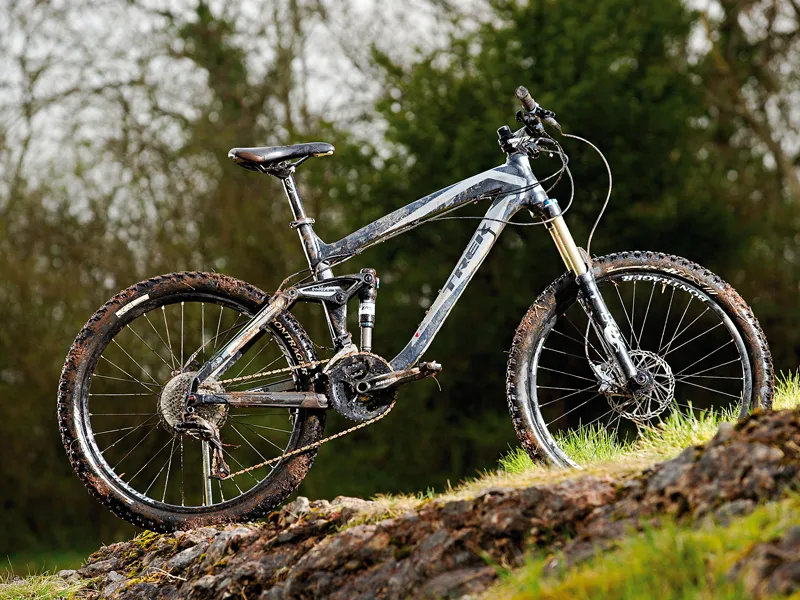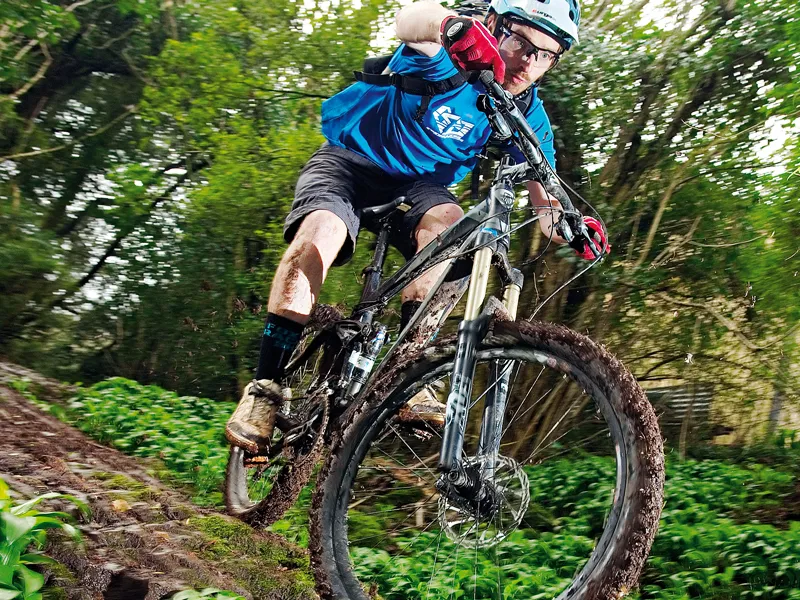Trek took the 160mm (6.3in) travel fork off the Remedy and we thought it was a real backward step, but now their Scratch bikes have taken over bigger-hit duties, the Remedy’s tough trail bike intentions are much better defined.
Even this entry-level model is a proper do-it-all option for new dabblers or dynamic riders alike.
Ride & Handling: Stiff frame, excellent tracking and feedback
The DRCV shock uses two inline air spring chambers, operating automatically in sequence in response to impact size. What that means in ride terms is a relatively tight, very pedal-friendly feel as you sit on the first, progressive feeling air chamber over small bumps.
Start hitting choppier, lumpier terrain though and a simple pushrod inside opens the second chamber to provide the deeper phase of travel. The chambers open and shut at an exactly matched pressure, so transfer between them is seamless and the overall control of the two chambers is superb. The fact that the bottom of the Free Floater swingarm-mounted shock moves down as the top is compressed also has a big effect on the overall feel.
Specifically there’s a much more controlled and predictable feel in the 25 to 75 per cent stroke range compared to single large volume cans, which often rush through the mid-stroke using travel for travel’s sake. There’s no need to run extra low-speed compression for pert pedalling feel either and once you’ve set pressures (using the handy clip-on sag indicator) the ProPedal lever is pretty much redundant for anything but fireroad sprints.
The rest of the handling is equally forgettable in a totally sorted way. We tested this bike with a wide range of riders from XC hardtail fans to Enduro DH podium racers and all of them came back full of praise. The longer stem and narrower bars combine with a relatively steep head angle to create a more trail rather than DH feel.
Progressive riders should therefore definitely think about upgrading to a short stem/wide bar cockpit. Having said that, it never let steep, rutted technical singletrack get the better of it when we raced it at Innerleithen. Even when we were braking and cornering hard enough to really feel the extended travel Fox fork twist and twang and the tyres slide in and out of traction over wet roots, the overall balance and high frame stiffness meant we never totally lost control.
The longer reach and less wander-prone handling also give it more balanced climbing manners, particularly on really steep, techy stuff. While it’s not light, the position and shock feel let it cover ground and gain height better than we expected.
Frame & Equipment: Stiff frame with cost conscious but still decent kit
Trek were one of the first companies to use a tapered front end, and the angular E2 tapered head tube is still an obvious feature.
The shared seam between the big truncated triangle down tube and steeply sloped hexagonal top tube, and a small gusset ahead of the seat tube, adds extra strength. It’s not a hollow axle rear end, but the single-piece EVO linkage and long ABP skewer works really well to lock down rotational rear wheel stiffness, and mud clearance is OK even with the 2.4in tyre.
Sandwiching the unique DRCV shock between the linkage and forward extensions of the swingarm – rather than anchoring it on the mainframe – means there’s room for a water bottle. The bottom bracket has mounts for an ISCG chain keeper and the fat down tube does a good job of acting like a Crud Catcher as well.
The seatpost needs cutting down if you want to get the seat really low though and there are no remote cable tabs if you upgrade to a remote post.
This is one of the cheaper bikes here, so Trek have had to cut some kit corners, but they’ve made sure it’s nothing that short changes the rider. The Avid Elixir 3 brakes are actually more predictable and reliable than their more expensive brethren once you’ve swapped to sintered pads. The open bath damped Fox forks are slightly heavier, but smoother over the small stuff than the more expensive FIT versions.
The SRAM X.7 gear all works fine too as long as you keep the cables clean, and the triple chainset syncs with the all-rounder ability of the bike. The longer stem and narrow bars create a more XC feel than the other bikes here too. The Bontrager tyres are relatively fast-rolling too, although broad rims give them a vast volume, and they’re tubeless compatible for low pressure running.
The really important component is the DRCV shock though. Not only does it use two inline air spring chambers, the side-mounted design squeezes a 220mm shock into a 200mm eye-to-eye length. The DRCV shock in Full Floater mount feels great.


